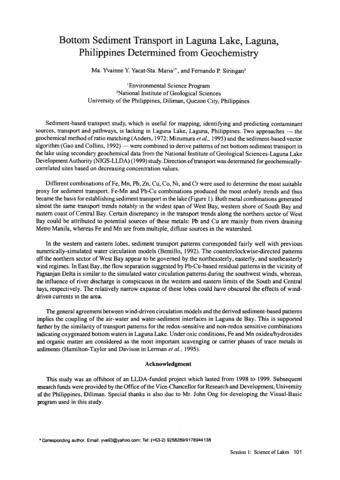Protein-degrading bacteria in the sediments of caged and uncaged sites of Lake Taal, Batangas, Philippines
| dc.contributor.author | Enriquez, Ma. Elizabeth V. | |
| dc.contributor.author | Lopez, Nellie C. | |
| dc.contributor.author | Barraquio, Wilfredo L. | |
| dc.contributor.author | Casauay, Arsenia A. | |
| dc.contributor.editor | Cuvin-Aralar, Maria Lourdes | |
| dc.contributor.editor | Punongbayan, Raymundo S. | |
| dc.contributor.editor | Santos-Borja, Adelina | |
| dc.contributor.editor | Castillo, Lourdes V. | |
| dc.contributor.editor | Manalili, Eduardo V. | |
| dc.contributor.editor | Mendoza, Marlynn M. | |
| dc.date.accessioned | 2021-07-27T03:42:13Z | |
| dc.date.available | 2021-07-27T03:42:13Z | |
| dc.date.issued | 2005 | |
| dc.identifier.citation | Enriquez, Ma. E. V., Lopez, N. C., Barraquio, W. L., & Casauay, A. A. (2005). Protein-degrading bacteria in the sediments of caged and uncaged sites of Lake Taal, Batangas, Philippines. In M. L. Cuvin-Aralar, R. S. Punongbayan, A. Santos-Borja, L. V. Castillo, E. V. Manalili, & M. M. Mendoza (Eds.), Proceedings of the First National Congress on Philippine Lakes (pp. 77-82). Southeast Asian Regional Center for Graduate Study and Research in Agriculture (SEARCA). | en |
| dc.identifier.issn | 1656-8099 | |
| dc.identifier.uri | http://hdl.handle.net/10862/6119 | |
| dc.description.abstract | The populations of protein-degrading bacteria in the sediments of caged (Leviste, Laurel) and uncaged sites (Quiling, Talisay) in Lake Taal were determined by means of the most probable number (MPN) enumeration using nutrient broth containing 12% gelatin. Protein degradation was checked through the liquefaction of gelatin. Results showed that protein degraders in the caged site had MPN of 1.53 x 1010/g dry weight of sediment while the uncaged site had MPN of 6.95 x 109/g dry weight. The populations were 4.98% and 50.0% of the total aerobic heterotrophic bacteria in the sediment for the caged and uncaged sites, respectively. The results indicate that: (a) active protein-degrading bacteria exist in the lake which could readily degrade any proteinaceous feeds present; and (b) there is no big difference between the populations of protein-degrading bacteria in the caged and uncaged sites, the latter possibly being a caged area in the past. These protein-degrading bacteria were identified as probably Bacillus, Aeromonas and Burkholderia. Isolate B44, a Bacillus isolated from the caged site, was found to be the most rapid liquefier of gelatin (liquefaction in three hours). | en |
| dc.language.iso | en | en |
| dc.publisher | Southeast Asian Regional Center for Graduate Study and Research in Agriculture (SEARCA) | en |
| dc.subject | Lake Taal | en |
| dc.subject | Bacillus | en |
| dc.subject | Aeromonas | en |
| dc.subject | Lake sediment | en |
| dc.subject | Protein-degrading bacteria | en |
| dc.title | Protein-degrading bacteria in the sediments of caged and uncaged sites of Lake Taal, Batangas, Philippines | en |
| dc.type | Conference paper | en |
| dc.citation.spage | 77 | en |
| dc.citation.epage | 82 | en |
| dc.citation.conferenceTitle | Proceedings of the First National Congress on Philippine Lakes | en |
| dc.subject.asfa | Bacteria | en |
| dc.subject.asfa | sediment | en |
| dc.subject.asfa | lakes | en |
| dc.subject.asfa | liquefaction | en |
| dc.subject.scientificName | Burkholderia | en |
このアイテムのファイル
| ファイル | サイズ | フォーマット | 閲覧 |
|---|---|---|---|
|
このアイテムに関連するファイルは存在しません。 |
|||
このアイテムは次のコレクションに所属しています
-
LakeCon2003 [49]
Proceedings of the First National Congress on Philippine Lakes




